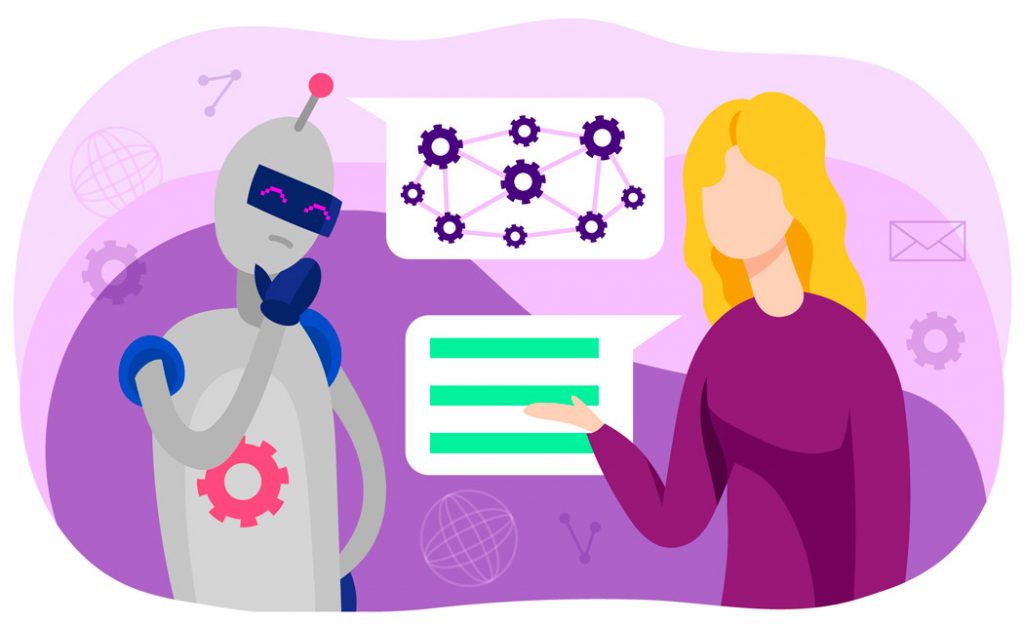People have always loved technologies that automates work and saves time. The latest trend that has caught the attention of most of the tech industry is chatbots. With a lot of research and progress in this area, chatbots have become even more human-like. Their accuracy and consistency in instant response to customer questions make chatbots more and more attractive every day.
What is a Chatbot?
Generally speaking, a chatbot is nothing more than a software that handles automated tasks.
Chatbot, with its simplest definition, is a software program that can discuss/talk with a person. For example, any user can ask the chatbot a question or ask for an explanation and the chatbot responds accordingly or performs an action.
Chatbot interacts in a format similar to instant messaging. Machine learning models learn from human interactions and allows computers to talk to people on their own without programming. Chatbot is basically a computer program that simulates human speech. It provides an interaction between a human and a machine through messages or voice commands.
Chatbots are programmed to operate independent of human operators. They can answer questions in natural language, like a real person, based on predefined scripts and combinations. When a question is asked, chatbots respond according to the database that contains the information it can use at the moment. It then improves itself for subsequent chats by updating its database with chat histories.
For example, if you ask Amazon’s Alexa, Apple’s Siri or Microsoft’s Cortana “How’s the weather?”, it will respond based on the latest weather reports available. The complexity of a chatbot is determined by the complexity of the underlying software and the data it can access.
Currently, many e-commerce companies are actively using chatbots to improve their customer service.
How Are Human Languages Processed By Chatbots?
Chatbots are currently being trained with big databases. For this reason, most organizations keep logs of their chat histories. Developers use these records to define questions that customers will ask. Developers then coordinate customer queries and develop optimally responsive bots with a mix of machine learning tools and models. If you do not have extensive data sets, you can choose different ways to train your chatbots.
How to Train a Chatbot?
Training chatbots happens much faster on a larger scale than human training. While normal customer service representatives are given manual instructions, a customer support chatbot is fed with a lot of conversation logs from which the chatbot can understand what kind of questions it can answer and what kind of answers it needs.
Chatbot Architecture and Working Methods
Chatbots work according to three classification methods:
1. Model Matches
Chatbots can generate an appropriate response using predetermined question-answer patterns. The customer journey is processed and a Q&A tree is uploaded to the chatbot, and the bot guides the customer through this tree.
Human: Who invented e-mail? Robot: According to Google, Ray Tomlinson invented email.
If your data set is not large, or you need a chatbot that offers specific options to your customer, or you want to quickly deploy a chatbot, this is the best classification method for you. A chatbot with 15-20 questions-answers specific to your purpose can automatically resolve up to 50% of your support requests and increase your sales by up to 30%.
With Infoset you can create a custom chatbot in minutes this way.
2. Natural Language Understanding (NLU)

Natural language understanding (NLU) is a branch of artificial intelligence that uses computer software to understand input in speech or text form.
NLU provides direct human-computer interaction and understanding of human languages by the computer without the use of if/else statements.
NLU is used in many systems including Alexa, Siri, and Google Assistant. NLU can detect the spoken text such as “What is the weather forecast tomorrow?”, and understand it as a request of the weather forecast at the current location.
We can list some common use cases of NLU as follows:
- Social media tracking
- Content recommendation
- Financial forecasts
3. Natural Language Processing (NLP)

Natural Language Processing or NLP is a field of artificial intelligence that gives machines the ability to read, understand and extract meaning from spoken languages. It enables technologies such as the chatbots we interact with on websites, voice and written commands we give to the assistant on our phone, Google Translate, word predictions while writing a message.
Today, NLP is experiencing an incredible boom, thanks to huge improvements in access to data and the increase in computing power that allows people to achieve meaningful results in areas such as healthcare, media, finance and human resources, among others. NLP algorithms usually work with the following steps:
- Tokenization: NLP breaks down a set of words into symbols or parts that represent linguistic values in the app.
- Sentiment Analysis: The program examines and learns the experience of the user and will transfer the query to a human when necessary.
- Normalization: The program processes text to find common misspellings that could alter the intended meaning of the user’s request.
- Named Entity Recognition: The program model of the chatbot searches for different word categories, regardless of what information is required.
- Dependency Parsing: The chatbot searches for topics, verbs, objects, common phrases and nouns in the user’s text to discover relevant phrases that users want to convey.
Result
Chatbots have affected almost all industries since 2016. The most prominent reasons for this are the benefits of chatbots; such as providing customers with a better 24/7 experience, increasing revenue and reducing costs.
You can create a free Infoset account now and start using our intelligent live chat and chatbot software in minutes. With Infoset, you can manage all your support and sales channels such as cloud call center, live chat, e-mail and social media from a single platform.





